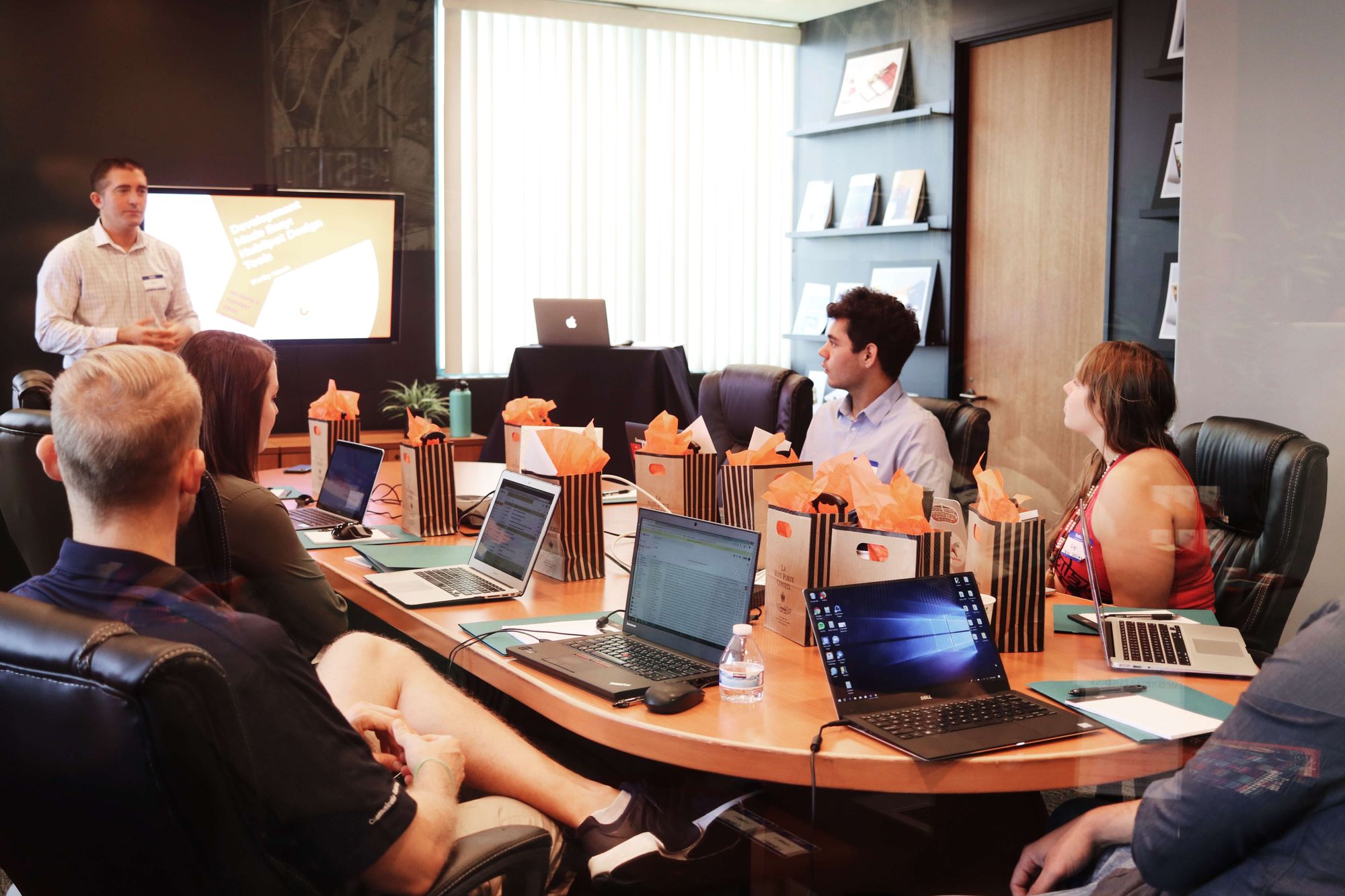Mudit Singh, Director of Marketing and Growth at LambdaTest, chats about going beyond product-led growth methods when it comes to marketing to developers.
You can listen to the full podcast interview on Spotify and Apple or enjoy the highlights of our convo in this article.

From coding to content: My marketing journey
Currently, I'm working as a Director of Product and Growth at a company called LambdaTest. At LambdaTest, we help developers and testers with online test execution and orchestration infrastructure. We provide a scalable infrastructure that can help them run manual, automation, and visual regression tests on the cloud.
For the past five years, I’ve been one of the founding members here at LambdaTest, and I’ve been doing a deep dive into the whole ecosystem of software development.
I’ve specifically been looking at the software testing area, understanding what the pain points are, how developers and testers collaborate, what tools software developers and testers use for their journey, and how LambdaTest can help out in the testing lifecycle.
Before LambdaTest, I was with a company called Algoworks. Again, I was there as the person who led the marketing and sometimes sales teams as well.
I started mainly as a developer when I graduated, but during that time, the era of marketing and digital marketing kicked off. So, I started as a content writer, but the universe had other plans for me. So, I went from a developer to writing for developers, and now I'm a marketer for developers and developer products.
So, that's how my journey started, and it's currently still going on. As I mentioned, I’m purely doing product marketing for developer tools and working with other companies as well who are in the same ecosystem.
I wouldn’t say that I was a proper developer as such, but we market a product that integrates with the development process and the testing process, specifically, automation testing. A lot of code is involved in the automation testing process, so I sometimes still have to code for the documentation side of things, but more around content and content generation.
One of the key things that we do in our marketing is specifically create content that’s tutorial in nature. It helps testers and developers start their automation journey, and that requires a lot of tutorial-based codes.

We work with a lot of third-party developers that are writers and testers. We collaborate with them on those content pieces and they write the code. So sometimes I run a cross-check for those kinds of things, but I’d say that’s less than five or 10% of my job.
I spend most of my time managing content planning, content writing, and other events that we’re currently doing.
Marketing to developers requires a new playbook
I have around 12 years of experience in the field of marketing, and when I started out, the type of marketing I was doing was mainly for e-commerce companies and other types of B2C companies.
When I went over to the B2B space, there was a lot of unlearning that I had to do, and there were a lot of things that I tried out that didn’t work from the get-go.
It's not 100% correct to say that it's not possible to market to developers. The definition of marketing changes a little bit when we sell developer-centric products, and it's not that traditional marketing methods don’t work, but they’re a little less effective.
So, we have to write a new playbook.
Currently, it's pretty advanced and there are a lot of good developer products out there that have set the path, a lot of methods that we’ve tried, and a lot of people are still doing them as well. But the core of a developer marketing playbook requires focus on enabling the end-user or end developer to use your product more effectively, rather than focusing on selling the product.

Highlight in as few words as possible what it does, how it helps you out, and how it can make your life easier. In addition to going into core marketing, things like how it can increase your ROI and increase your productivity, those kinds of things work as well, but your core focus should be on the enablement side of things.
So, start with things like documentation and tutorials, focusing less on ads and more on how to build up a community of people, a community of developers, programmers, testers, project managers, and people who are involved in the whole development lifecycle. Build up a community of those people so that everybody can evolve as your product evolves.
The ultimate aim is to make people’s lives easier, to solve a core problem statement that you’ve identified earlier when you’re doing a product market fit, and to deep dive into that problem statement and solve it in the best way possible.
Usually, in a developer marketing scenario, impulse buying doesn’t happen. But impulse discovery happens, so people are coming across a particular challenge and during that journey, they try to find tools, libraries, or any other product that can help them out with the difficulty that they’re facing at that particular time.
And when they go to a web page, go through an ad, or any other discovery source, they go there and they just find fluff. They find out how this tool helped with XYZ, how it increased revenue, etc., but they don’t find out what the exact features are that can help them out immediately. “Is this tool something that I can use right now to solve my problem or not?”
Those kinds of tactics, which are related to a very enterprise-centric approach that talks about numbers but doesn’t go into the features, sometimes don’t work. So, when we market to developers, we have to focus on how we can solve the challenges. Then, at the same time, we can focus on how much we can solve their challenges.
They don’t want to go through a load of fluff. They want to have a problem statement right now, and they want it solved. Be clear and precise in explaining exactly how you're going to help them out, and just go ahead and do it.
There's also another approach that’s very popular right now that’s called product-led growth or a product-led approach. What that means is let's not put a layer of salespeople or demo people in-between, enable them to explore the product and use the product, try it out, and see if it’s able to help them out.
If they feel that this is something that’s helped them out right now and can help them out in the long term, they will of course buy the product.
We have to enable them, to create an ecosystem that helps them explore the product, helps them get educated from their own end, and that they can get value out of immediately. This will assure them that this is the right investment for them, that they can go ahead with the product and use it for a long time.

The rising influence of developers in a digital-first world
People are adopting more and more digital technologies, and nearly all companies these days are going digital-first. Even traditional retail companies like Adidas, Nike, and all these other companies are adopting big digital transformation strategies, and they’re placing a very heavy focus on digital-first.
All the experiences that they want to present to their end users would be digital. In fact, the strategy has become more aggressive, especially after the pandemic when people weren’t able to go out to traditional brick-and-mortar businesses. Nnow everybody wants to accelerate their digital experiences as well.
What that means is that for developers, testers, and anyone involved in the software development lifecycle, their roles have become more and more strategically important for businesses. And they’re investing very heavily in that.
The day-to-day lives of developers and testers have become more complex in nature. They have to do a lot more stuff and they have to release a lot more features. Otherwise, the business that they represent won't be able to compete in the market.
They’ve had to increase their productivity by multiple folds, specifically in the last five to 10 years after the emergence of mobile and 3G, 4G, 5G, and soon 6G is going to come. All of these innovations have accelerated digital experience and digital transformation-based efforts.
One of the ways to increase that productivity is by using or enabling developers and testers with the right set of tools.
Every push is being done to build and scale up tools that are focused on the software development process. That means a lot of innovations are happening, a lot of new companies are coming up that create tools that focus on one small problem statement, and sometimes very big companies like Microsoft come up with complete suites that enable software development processes.
So, when new tools come out, it's their job to reach out to developers and reach out to people whose lives will become easier with these tools. So, this is one of the reasons why developer marketing as a profession or as a field is developing as well.
More and more tools focusing on developers, programmers, and testers are coming into the market, and more and more requirements are emerging to build a specific ecosystem to attract developers and testers to their specific tools.

Even if we don’t talk about developer tools and we talk about other aspects, right now, businesses don’t interact with each other in a traditional manner. They interact in an information technology age. They have APIs now, so they interact through programs.
For example, a bank doesn’t directly wire transfer from Adidas to a bank through a checkbook. Now, they do it directly through a payment gateway.
It's just one small example, but the bigger picture is that all these businesses are regularly interacting with each other through APIs, which are, again, driven by developers and testers. All of that has to be tested, all of this ecosystem has to be tested or developed and worked upon. For that, we need tools as well.
The way that people and companies do business is changing. We’re seeing more and more types of tools that make their lives easier and enable these kinds of interactions.
Shifting power dynamics: The rise of small teams in tech purchasing
The power dynamic in the buying process is changing a little bit. In fact, it’s something that’s being pioneered by companies like Amazon. Rather than focusing on very large teams of hundreds of people, they focus on smaller teams of 25-50 people who are working on a specific problem set.
These companies are providing the smaller teams with a set budget. So there are tools that are employed organization-wide, and they require a lot of R&D and sales work, and all of those things that are required to roll out across whole companies.
For example, if you want to use an HR system, you’ll need something that’s rolled out across the whole company.
But for developers, one advantage we have here is that the whole team is provided with a set budget, and they can use a tool for that small set of teams.
We’ve seen in the past that there are multiple teams across multiple geographies and multiple projects as well. But they’re all part of a bigger organization who are using either the same tools or sometimes even competing tools. So, there’s a possibility that a team somewhere is using Slack, but at the same time, another team is using Microsoft Teams or some other tool for their own efforts.
So, although companies consolidate and bring all their tools together company-wide, there are still small teams who are independent in nature who acquire a different set of tools. That also opens up the ecosystem a little bit.
Now, multiple products can exist simultaneously, and it becomes more important for all of these tools to talk with each other and create a very integrated ecosystem, so different tools used by the same team or used across the same company are able to communicate with each other. APIs, again, help enable that, and tight integrations help enable that.
It also makes it a little bit easier to compete with new tools and attract developers’ attention to your product, and I'll tell you why.
You have a tool that very tightly fits within the ecosystem, so what you do is partner with those ecosystem tools.
For example, there are a lot of tools that are just working over and above the JIRA ecosystem or Atlassian ecosystem, a whole set of tools that are just integrations and are thriving along with Atlassian and other smaller players.
For a company like Salesforce, there were tools that just integrated with Salesforce, and other tools that integrated with Salesforce and enabled smaller things that Salesforce wasn’t able to do on its own.
On the other spectrum, you have a tool that doesn’t have as high a user base, but now you have an opportunity to enable other people to build tools over and above you so that you enable the ecosystem as well.
Marketers can now use and target this ecosystem. If you're using JIRA or a tool that integrates with JIRA, it’ll make your life easier. If nothing else, you can partner with JIRA or Atlassian so that you guys can co-sell each other. So those kind of partnerships can happen as well.
This is one of the marketing techniques we used in our early stages at LambdaTest. In fact, it’s something that continues to happen right now. LambdaTest as a testing tool integrates with project management tools, so we work with them on the integration side of things and integrate LambdaTest with other project management tools.
And then we work with these project management tools for co-marketing activities. We create a webinar for them, they create a webinar for us. We send newsletters for each of our audiences, create joint press releases, and create joint social media engagement so that both user sets of tools get to know about this integration and can explore either of the tools.
If they’re using both tools, they can integrate them and increase their productivity because these tighter integrations enable them to do more in less time. It’s a win-win for everyone.

Evolving strategies in product-led growth
Product-led growth (PLG) is very popular right now, specifically among software-as-a-service tools. But the definition of the PLG playbook is still evolving.
Previously, the complete focus was on the user journey and ensuring that people are enabled as aggressively as possible and they’re able to get value out of the product.
But then people started to realize that we first have to bring them to the product, that there should be a discovery element involved in that. People started focusing on social media platforms, SEO, and the discoverability of that product. And that becomes part of the PLG playbook, as well.
So, it's something that’s pretty much evolving, and at the same time, it's interesting to see that things that we usually term as traditional marketing approaches are somehow becoming part of the PLG playbook as well.
For example, we always used to say events are purely traditional marketing. But now, because of the virtualization of everything, events are happening virtually at a fraction of the cost. And now people are aggressively doing webinars. They term it as product enablement webinars, demo webinars, or sometimes integration webinars, but those are events as well.
It's like you're doing a specific event for a specific set of audiences. And now, this playbook has evolved in PLG companies as well. Any PLG company will see there’s always a book or a demo, or they’ll have a regular cadence of webinars that are happening either to enable their users or to educate their users more on the tool and become part of the whole PLG playbook.
Developers and testers aren’t very receptive to ads, but that doesn’t mean that the ads don’t work. Sometimes they do, but you just have to rethink the way you do them.
We used to do gated content and bring audiences to that gated content through ads for things like ebooks and whitepapers. This was a traditional marketing approach: content in a bundle format.
But now we’re providing that content, again, in a bundle format, but not gated. For example, a complete ebook on how to use a particular tool to achieve XYZ, a complete white paper on how people have been able to solve these problems, and things like surveys. People release ‘State of XYZ’ surveys.

All of these were traditional marketing approaches, but now they have to rethink the approach and put it in their core PLG market playbooks. Content generation is still very much a PLG thing, but they’ve evolved how they do it. So the playbook of the product-led growth marketing approach is still evolving.
Coming back to ads, platforms like LinkedIn provide you with very precise targeting of ads. Let's say your precise targeting would now be aimed towards developers or developer decision-makers, and the type of ads that are provided there would be a little bit different. This is seen in playbooks from companies like GitHub, Microsoft, and Google.
For example, Google has a defined set of ads that they target towards developers, focusing on things like productivity features, maybe sometimes case studies, or whitepapers.
And then there are EdTech companies that are selling courses to developers to enhance their skill set.
So, ads still work, but the approach to doing those ads is a little bit different. So, once you’ve set up a PLG engine, you have to look at different things. You want to add more channels because you can’t grow unless you have an exponentially growing different set of channels.

One channel alone may not be able to scale you up unless you’re a company like Slack. But even Slack had to add a scale and start taking different approaches as well. They had to start doing events, they had to start doing ads.
Once you scale up to one level, you have to add more and more marketing channels, and that means going back to your traditional marketing roots. But again, a twist is the fact that your audience is a little bit different, so the way to market to them using these approaches would be a little bit different.
Some may argue that this is true for nearly everything. It depends upon the industry to industry, the type of audience you have, and you tweak your ads and everything. But, I can also say that with a product that you have, it provides you with a different set of opportunities to run ads that don’t directly convert, but push people to convert in a PLG cycle.
Do a slightly different approach than the traditional approach to push your core PLG engines. That’s a way to evolve your current PLG engine to a little bit of a different pace.
Measuring multi-channel success in developer marketing
One of the best things about product marketing or software-as-a-service marketing is that we have very clearly and easily defined metrics. We have people coming to the website, which is traffic, and people coming to sign up. Maybe if you're a freemium product or if you're a free trial product, then people who are activating or using features of your tool, and then finally people who are selling.
Sometimes if you're a bigger company, you can also add metrics around upsells. So you sell one product and you have multiple product lines, then you sell more of those product lines.
There’s also bringing people to your site, which is acquisition, engaging them, converting them, and activating them, so conversion rates. All of these KPIs are pretty much mapped, and any product campaign that you do will have a direct effect on one of these things.
If you're running ads, maybe you have a predefined goal of bringing more and more traffic to your website or more signups to your website. If not that, maybe you’re doing a webinar and you’re running ads for that webinar. So now the aim would be to bring in more registrations for that webinar.
Once that webinar happens, you have a set of leads that you nurture through your email marketing campaign, and then the tone becomes how to activate them or how to engage them, and then finally convert them.
You have multiple sets of funnels, and each campaign that you do would have a very well-defined objective, and it starts off with what you’re going to achieve for each step of the funnel.

Once they’ve entered into that step of the funnel, then you have another set of campaigns whose job is to accelerate to the next step of the funnel.
Because we have developer mindsets, we’re pretty data-driven in this approach. Specifically, one of the hallmarks of a developer marketer is that they’re very data-oriented and they have all these numbers. Whenever they’re running any type of campaign or marketing activity, they have all these KPIs that they can track and leverage for their next groups.
Our aim is to enable the developers to solve their problems. It becomes a little bit complex when you have multiple sets of product lines or multiple sets of features that do different things.
So, once you have somebody who signs up, they may have a different set of expectations that aren’t available instantly with the page that they’ve visited or the tool feature that they’ve checked.
Maybe through your email marketing or your other set of marketing channels, you can highlight to them that you have another set of features as well, so maybe you can connect and understand what problem statements they’ve faced that you weren’t able to solve here, and maybe you have an alternative for them.
We’re building up an enablement ecosystem. If not with your tool, maybe with your partner tools, and both of your tools can work together. If your set of features isn’t working, maybe you have content that provides a solution for them. So, through your content marketing efforts, let's say blogs or tutorials, you’re enabling them to find the solution to your problem.
I see it as a brand-building exercise. When they have a problem that your tool can solve, you’ll be the first one that they’ll reach out to.
The aim is to make the lives of the developers and testers easier, and whatever activities you're doing should be geared towards that core aim.
Tackling the challenges of marketing multi-feature tools
Even if you have a very different set of products, they’re usually all interconnected in one way to solve one core problem.

When we talk in terms of SEO, your small set of features are longtail keywords that do that, but ultimately, the whole platform would be those core two-phase or two-word keywords. So that’s something you can start off with.
You market your tool as something that’s a bigger ecosystem, then highlight to them that, “As part of this ecosystem, I also do this and this, I do ABC, these three types of things.” You have to ensure that if somebody's looking for a problem statement that connects with your one feature set, they’re able to discover your tool as well.
Let's take the example of Salesforce. It's not just a CRM, it’s evolved way ahead. If somebody searches for marketing automation tools, you're able to discover Salesforce. If you're searching for a CRM, you're also discovering Salesforce. But it's a very big tool whose ultimate aim is to manage and automate enterprise operations.
Those kinds of things are also there in Salesforce, so you can build up complete solutions. Those kinds of things are added.
In my case at LambaTest, we have tools for a company, but sometimes not all these tools are required. So if you’re a developer tester who’s just starting out, you won't need automation testing from the get-go, you’d need tools for manual testing. There’s a set of tools for manual testing, then as they evolve, they’d need automation testing, and then they’d need things like visual regression testing.
Or, if you do a completely different thing in mobile app development, we do mobile cloud, so that’s also what we have here.
We have multiple different tools, but now what that also means is we have multiple products. There’s a small set of features and a small set of products to market.
In fact, that’s one of the reasons why big companies have multiple product marketing managers whose job is to take care of one set of features. That approach can be done as well. That means you have one set of features marketed.
Also, at the same time, highlight everywhere in your cycle that, ‘If this feature isn’t something for you, we have another set of features as well.’ You can maybe do this through the email drips that you’ve set up, maybe through remarketing ads.
Another time where ads come into the picture is when people have visited your website but have now exited. So maybe you can run remarketing ads to find out if they were interested in another set of features. So, those kinds of things can be done.
The aim is to set up a loop and an ecosystem of tools so that if not one tool can help out, maybe another set of tools can, or maybe a combination of another set of tools can help out.

Leveraging community for brand success
For us, SEO has been one of the most important value drivers. But as we’re growing, the pure SEO-based revenue and traffic that we’re building up isn’t the only thing we want to focus on. We want to branch out on other sets of channels, so other channels are also working for us.
But I'll say that one of the things that companies should try out that aren’t marketing assets are more community building or community enablement things. It’ll have a broader impact on what we call traditional branding. As I said earlier, our aim is that whatever we do should be on community enablement and that ecosystem enablement.
For example, we did a flagship event last year, and we're going to do it again this year as well, and it’s called TestMu. The whole premise of that event was rather than selling LambdaTest at that event, we should instead build up a community, we should enable other developers and testers to come together, talk, discuss, and plan out the future (in our case, the future of testing).
This involved bringing different sets of thought leaders together, for example, from enterprises, from other tools, from open-source networks, open-source tools, and people who are working on that, along with other industry experts, and connecting them with people who are starting their journey or maybe at a mature cycle, and set up that community through one flagship event.
At the same time, we aimed to connect our partners with that community so that they could either interact better or get to learn better. And that built up that whole ecosystem whose job was not to drive sales for LambaTest, or in fact even signups for LambaTest.
The whole job was to create an ecosystem and make LambaTest part of that ecosystem so, whenever somebody talks about LambaTest, they say, “This is a company that’s helping our community out in the best way possible.”
So, it's not necessarily that you start off big by doing a big event, you can do small stuff as well. Maybe contribute to open-source repositories, and if not monetarily, maybe through your effort or other things that can help out the developers and tester communities.
One thing for us is that because we use a lot of open-source tools, we’re dependent upon a lot of things that are built by the community. Anytime we get stuck, anytime we’re facing a challenge, we go to a community, find a solution to that problem through Stack Overflow, or other types of communities.

We also go to a lot of free events and check out a lot of YouTube videos that are there, so this is a community that’s kind of helping each other out without any monetary incentive involved.
You can become part of that as well. You can do an event that enables these creators and enables this community as well, to make the life of other developers and testers easier.
Even though it's a very open community, sometimes siloes start to form. That means a set of people are talking in a very tight-knit community and that learning is limited to that specific place.
Maybe you can contribute in a way where you can connect the silos and bring people from different segments into a singular platform so that learning can be shared. It can cross from one silo to another silo, or in fact, just break the silo itself and reimagine the way people are interacting to build up this ecosystem. That’s been something that’s become a very interesting part of this community building.
I think one of the aspects of product growth has become a community-led growth thing. People are very focused on building up these kinds of communities from the start, sometimes at scale, but the ultimate aim has become to build up a community to help out other people in the same area in the same industry segment.
Key strategies for community enablement
If you're marketing to the developer community, focus first on the enablement part of things. Focus first on building up the ecosystem with the aim of how you can solve the challenges of this core ecosystem, and that will translate to the growth of your product as well.
Another thing I want to highlight is that you should be very receptive of feedback, and in fact, you should go above and beyond to get that feedback. Feedback from other community members is gold; it really helps you to evolve the product.
Usually, people say it’s the job of product managers or project managers to listen to the customers. But as marketers ourselves, we’re more involved with the community and we have better visibility on their pain points. So maybe we’ll have a better understanding of translating those pain points into product features.
As a marketer, it’s your job to look deep into that community, find out what challenges they’re facing, and communicate that back with your own teams that these are the problem statements and maybe we can help out. Maybe our tool can evolve in such a way that it helps out.
Be very vigilant about the feedback that you can get or you're getting about your platform.
Join our Slack community to network with marketers and developers and discuss topics like PLG and beyond.






